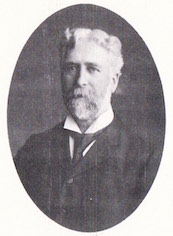Tropical Ravine history
Key to the history of the ravine is the life and work of Charles McKimm, its designer.

Charles McKimm and his ‘Fernery’
Charles McKimm born outside Donaghadee in 1840 and came to the Royal Botanic Garden in Belfast in 1873 after an apprenticeship at Farnham Estate, Cavan. He was promoted to head gardener three years later and the family lived in the impressive Italianate curator’s house situated close to Friars Bush graveyard wall.
Under the administration of a Board of Directors responsible to shareholders (operating as a private company), the gardens then covered a large area stretching to the banks of the River Lagan. Finance always posed a huge difficulty. Subscribers had full access, with the public allowed entry for special events staged to raise money. Despite financial restrictions, Charles McKimm made great improvements. Botanic and Malone gate lodges were rebuilt. An exhibition hall and nursery houses were constructed. Special features developed included a Towering Gazebo to view Cave Hill and Black Mountain.
His 26 years in charge brought him great respect and he was especially famous for bananas, endless varieties of pompom chrysanthemums and the spectacular borders he created. Known as a great character, respected by all ages, he umpired (frock coat removed) summer evening cricket matches on the great lawn enlisting the enthusiasm of his 7 sons, friends and neighbourhood youth.
Victorians had a great fascination for the world of ferns. Initially known as the Fernery, the building on the site of the orchid houses was entirely his conception, design and was built by his gardeners. The Tropical Ravine House received much acclaim, pronounced as “One of the most splendid Fern Houses of Europe” when officially opened in 1899. The planting on different levels allowed the cultivation of a great variety of plants suited to varied light levels and temperatures. Interest was given to the preservation of the Killarney Fern, then almost extinct. Plant stocks were continually enhanced by donations from other Botanic Gardens, private collections and world travellers including naval officers and missionaries.
As today the upper peripheral gallery allowed views over the dense jungle planting interspersed with glimpses of the ground level Scrabo stone walls and planted banks accompanied by the noise of cascading water pumped from underground wells.
In 1896, after years of negotiations by the Directors, Belfast Corporation was persuaded to take ownership of the Gardens. Charles McKimm remained Curator and was also appointed the first “General Superintendent of Parks” for the City of Belfast.
Funds were available to renovate and extend the Tropical Ravine and repair the Palm House. All City parks saw improvements and deciduous tree planting in streets to reduce pollution levels began. Victoria Park was designated by him and opened in 1906 for the population of East Belfast to enjoy. He also designed the gardens around Belfast City Hall.
Following a sudden illness, he died in 1909.
Today the completed restoration of the Tropical Ravine House has reinvigorated interest in this unique building dating from the Victorian era with its amazing plant collection.
During the restoration project, much of the history of the ravine building and its planting has been assembled by Botanic Gardens staff from old newspapers, the Public Records office, plant accession records from Kew Gardens and other sources. We hope to bring you some of this archive in the future. Meanwhile here is one image of the building in its early form. Note the lantern roof which has been re-instated in the modern restoration.

